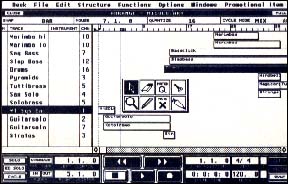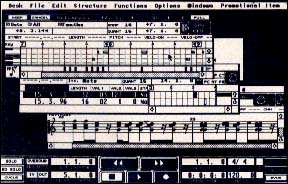Review
CUBASE
Pro-Level MIDI Sequencer
BY DAVID SNOW
| AT A GLANCE | ||
|
||
Advances in hardware and software design fuel the technolust of power-mad computer jocks. Once you've laid hands on a product that makes your work faster or more intuitive, it's very painful to go back to the older ways. That's my gut response to Cubase, Steinberg/Jones' entry in the pro MIDI sequencer race. Cubase combines the best of several sequencing styles into a logical and efficient graphic environment.
The program requires a monochrome monitor and at least 1MB of RAM. The included optional M-ROS (MIDI Real-time Operating System) multitasking system requires two or more megabytes to load more than one program. The current version of M-ROS even supports programs not specifically developed for it and comes with a switcher program to configure and launch multiple applications. (Editor's Note: See Jim Pierson-Perry's article, Multitasking on the ST, elsewhere in this issue for more information on multitasking). Steinberg/Jones programs employ cartridge-port hardware keys for copy protection. Using Cubase with similarly protected programs requires their cartridge port adapter to accommodate additional keys. For this review, I used a 1MB system and evaluated Cubase solely as a standalone program.
Cubase version 1.5 sports a number of enhancements over the original release version: a new editing window, a new quantization type, an Auto Save function, support for Moniterm's 19-inch monochrome monitors, and a built-in mouse accelerator. In addition, Steinberg/Jones has corrected compatibility problems with GDOS and TOS 1.4 (though it's still incompatible with the popular PinHead system accelerator program from CodeHead).
 |
| Figure 1: The Arrange window in Cubase handles basic recording and shows the current Track List and Part Display. |
For the Record
Despite its complexity, Cubase's superbly designed user interface makes it easy to get up to speed. Cubase windows are similar but more sophisticated than standard GEM windows. You can open up to seven windows and, in addition to horizontal and vertical scrolling, the contents of a window can be magnified or reduced in size. Click the right mouse button to invoke a pop-up "toolkit" menu to change the function of the mouse pointer. You can activate many program functions either with the mouse or the keyboard.
Cubase emulates a multitrack tape recorder as its basic model. An arrangement can hold up to 64 tracks, and four tracks can be recorded simultaneously. You can handle recording and playback through a screen transport bar or by remote control from a MIDI keyboard. Counters in the transport bar display song position and SMPTE time, current tempo, time signature and loop points.
Extensive real-time editing control sets Cubase apart from the competition--virtually all program operations are active "while the tape is rolling." The Arrange window (see Figure 1) handles basic recording and shows the current Track List and Part Display. The Track List holds the names, instruments, MIDI channel assignments and drum map status for each track. You can add or delete tracks from the list at will. Recording options include overdub/replace mode, automatic/manual punch mode and normal/cycled (looped) recording.
Parts is Parts
Recording a musical segment of any length creates a "part," the basic music structural unit in Cubase. Parts appear in the Part Display region of the Arrange window as a rectangular bar assigned to the track you are using. The part is not locked to that track; you can move or copy a part to any position in any track by clicking and dragging it with the mouse. Other part editing features include split, append, merge, overlap and delete. Any number of parts from the same or different tracks can be grouped and handled as a single entity, making it easy to manipulate musically related material. One particularly useful option is the creation of "ghost parts," linked copies of an existing parent part. Edit the parent part and you change all the linked ghosts.
Double-click on a part to call up a dialog box where you can alter playback properties of that part. Cubase makes these changes on the fly, without affecting the original recorded values, so you can safely experiment. Playback options let you transpose pitch; alter and compress velocity; and enable/disable program change and MIDI volume, time-delay and filter controller data. You can modify playback parameters for a single part, all parts on a track or over an entire arrangement.
Each track is assigned a MIDI channel and an output port (the ST internal port, unless an optional Steinberg/Jones hardware adapter is used). All parts in a track play on this designated channel unless it's set to the "No" value, in which case they play on the channel from which they were originally recorded. You can also pipeline track playback to other active M-ROS applications.
All parts in an Arrange window constitute an arrangement. You can open several Arrange windows at the same time and copy, cut and paste between them. An arrangement can be handled as a complete piece of music or as a section of a piece. At the largest structural level, all open Arrange windows constitute a "song." A song can be a single piece of music or a set of individual pieces, depending on how you treat arrangements. You can save and load songs, arrangements and parts as individual disk files.
It's All in the Timing
Cubase has a timing resolution of 192 ticks per quarter note. You can set Cubase to derive timing from the internal M-ROS clock, external MIDI clock or external SMPTE (via incoming MIDI Time Code or optional hardware SMPTE interface). Cubase simultaneously transmits MIDI Time Code and/or MIDI Sync messages (MIDI clock, start, stop, etc.).
The built-in metronome can beep through the monitor speaker or be sent out as MIDI note messages to a suitable instrument (e.g., a rimshot on a drum machine). A "Human Sync" option lets you control tempo in real-time while playing or recording; tempo is calculated by comparing the timing of incoming notes to a user-definable rhythm mask. To get appropriate Human Sync parameter settings can be tricky, but it works and is uncannily responsive. Cubase offers a wide selection of quantizing algorithms, all of which can be undone unless specifically frozen for a part, track or arrangement. Quantization values are gridded to standard duplet and triplet note values (no quintuplet or septuplet groupings), ranging from a dotted whole note to a sixty-fourth note triplet. Variations include: standard autocorrection of note start times, intelligent autocorrection retaining the "feel" of your playing, iteratively nudging notes toward a time grid, analytic quantization that distinguishes between duplets and triplets, matching the feel of one part to another and matching a part to a pre-defined rhythmic map. You can create your own "groove map" for this purpose, or select one supplied by the program.
Other useful features include input filters that block particular categories of MIDI data, redefining incoming MIDI controller data from one type to another, plus MIDI Thru and Running Status toggles. A MIDI Processor is available to create echo, chorus and pitch-shift effects in realtime.
Song files from the Steinberg/Jones Pro 24 III Sequencer are upwardly compatible with Cubase. It also reads MIDI Standard Files (formats 0 and 1) and can write format 1 MIDI Files.
In the Cutting Room
Cubase offers four conventional edit modes, each with its own window format (see Figure 2): Grid Edit (event list with graphic display), Drum Edit (time-grid), Key Edit ("piano roll" display) and Score Edit (standard musical notation). These windows operate in a similar fashion--master one and you've pretty much mastered them all. All edit modes support step-time entry and cut/copy/paste/undo. With the exception of Grid Edit, all can take multiple parts into one window. You can record from any edit window and toggle from one window to another while playing or recording. Data edited in one window is automatically updated in other open windows. Changes made within an edit window do not get finalized until you close the window.
 |
| Figure 2: Cubase offers four conventional edit modes, each with its own window format: Grid Edit (event list with graphic display), Drum Edit (time-arid), Key Edit ("piano roll" display) and Score Edit (standard musical notation). |
A fifth edit mode, Logical Edit, modifies parts and tracks according to specified logical test conditions (e.g., set all occurrences of a specific pitch in a part to a selected velocity). Logical Edit requires familiarity with the nature of MIDI data in order to be useful, but is great for experimentation and makes a convenient editing tool.
The Dynamic MIDI Manager is a "virtual mixing console" of graphic faders, dials, switches and numeric displays which are programmable to transmit any kind of MIDI data in real-time. It is primarily for control of volume, panning, timbre or similar parameters. You can record output either as a static "snapshot" or a dynamic stream of MIDI data. Selection and function of graphic objects in the MIDI Manager are user-definable and may be saved to disk. The program comes with an assortment of MIDI Manager "maps" customized for some popular synths.
Cubase comes bundled with the Satellite patch editor/librarian utility which transmits and receives patch dumps, either singly or in banks. Satellite edits patch files following the format used in the Steinberg/Jones Synthworks series of patch-editor programs. A Macro Editor with sliders tweaks parameters for the DX1TX7, TX802, D50, ESQ-1/SQ-80, D10/20/110, MT32, K1 and M1 synths.
But Does It Do Dishes?
Any sequencer with this range of capabilities would have much to recommend it. Its friendly and efficient graphic environment makes Cubase all the more attractive. The manual is excellent, with many illustrations, a comprehensive index and a chapter on MIDI basics for beginners. As for bugs, I encountered no lock-ups or bombs (multi-program operation under M- ROS was not tested for this review, however). If you've got the bucks, Cubase is highly recommended.
David Snow holds degrees in music composition from the Eastman School of Music and Yale University, and is the recipient of numerous commissions, awards, and grants, including those from BMI, ASCAP, and the National Endowment for the Arts. This is his first review for START.